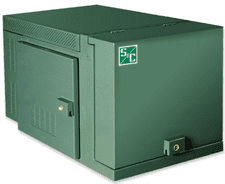Ergon Energy Wants To Get Some Remote Customers Off The Grid
Queensland network operator Ergon Energy is looking to take some remote customers off-grid rather than continuing to pay for the maintenance and upgrade of part of its sprawling network of 65,000kms of poles and wires.
Ergon Energy CEO Ian McLeod says the costs of new technology – such as solar and battery storage – meant it now made sense that some customers have stand-alone energy systems rather than being connected to a centralised power supply.
“We will be looking to take uneconomic supplies off the grid. We’ve been approached by a proponent who got a few customers out there, put standalone energy systems in,” McLeod told RenewEconomy on the sidelines of the All Energy conference in Melbourne.
“When you are at the edge of the grid … it starts to stack up when you take customers off. That’s of benefit to the rest of the customers too.”
Ergon Energy operates one of the biggest networks in the world – it covers 40 per cent of the main National Electricity Market by area – but only has 7 per cent (around 700,00) of the NEM’s customers .
That means it relies on a Consumer Service Obligation to effectively “cross-subsidise” the cost of delivery of centralised power. That can be up to $14,000 a head per annum for remote areas, and an average of $2,500 west of the Great Dividing Range – in other words, much of its area.
McLeod is pushing for those costs to be “visible” so that Ergon Energy – and policy makers – can make choices about how electricity could be delivered.
 Chip in a few dollars a month to help support independent cleantech coverage that helps to accelerate the cleantech revolution!
Chip in a few dollars a month to help support independent cleantech coverage that helps to accelerate the cleantech revolution!
“I’d like to see the cost of those connection to be visible so we can look at alternative technologies and reduce our costs,” he told the conference. “Some solutions will be off grid, and some solutions will be on grid.”
Ergon Energy this week announced it would start rolling out a series of battery storage installations to deflect the cost of grid upgrades.
 A first round of 20 such storage devices – 100kWh – will be installed from next year. McLeod says there could be “hundreds” of such installations located along its network.
A first round of 20 such storage devices – 100kWh – will be installed from next year. McLeod says there could be “hundreds” of such installations located along its network.
“The network was designed for low-cost supply of light and power years ago. But it doesn’t meet today’s requirements,” McLeod told RenewEconomy later.
“The advantage of the GUSS battery storage systems is that it is mobile, it deals with voltage quality issues, and it can provide more power more needed.
The units will be installed next to substations and along the line. “In the past, it would take 12 months to get an easement. Here, we just provide a pad next to the line and put battery unit in there.”
McLeod says the networks and the energy supply industry was clearly evolving, and quite rapidly. Ergon Energy, he says, had been able to deflect more than $600 million of network augmentations in recent years due to energy efficiency measures and demand management.
Storage and distributed generation would provide the next opportunities to do the same. The network, he says, would become a “market enabler”.
“We don’t care if the electricity supply comes from the roof, from the sugar mill, from the rubbish tip, or from centralised power station. We just want the market to determine what the best price is.”
Source: RenewEconomy. Reproduced with permission.
Have a tip for CleanTechnica? Want to advertise? Want to suggest a guest for our CleanTech Talk podcast? Contact us here.
Latest CleanTechnica.TV Video

CleanTechnica uses affiliate links. See our policy here.
